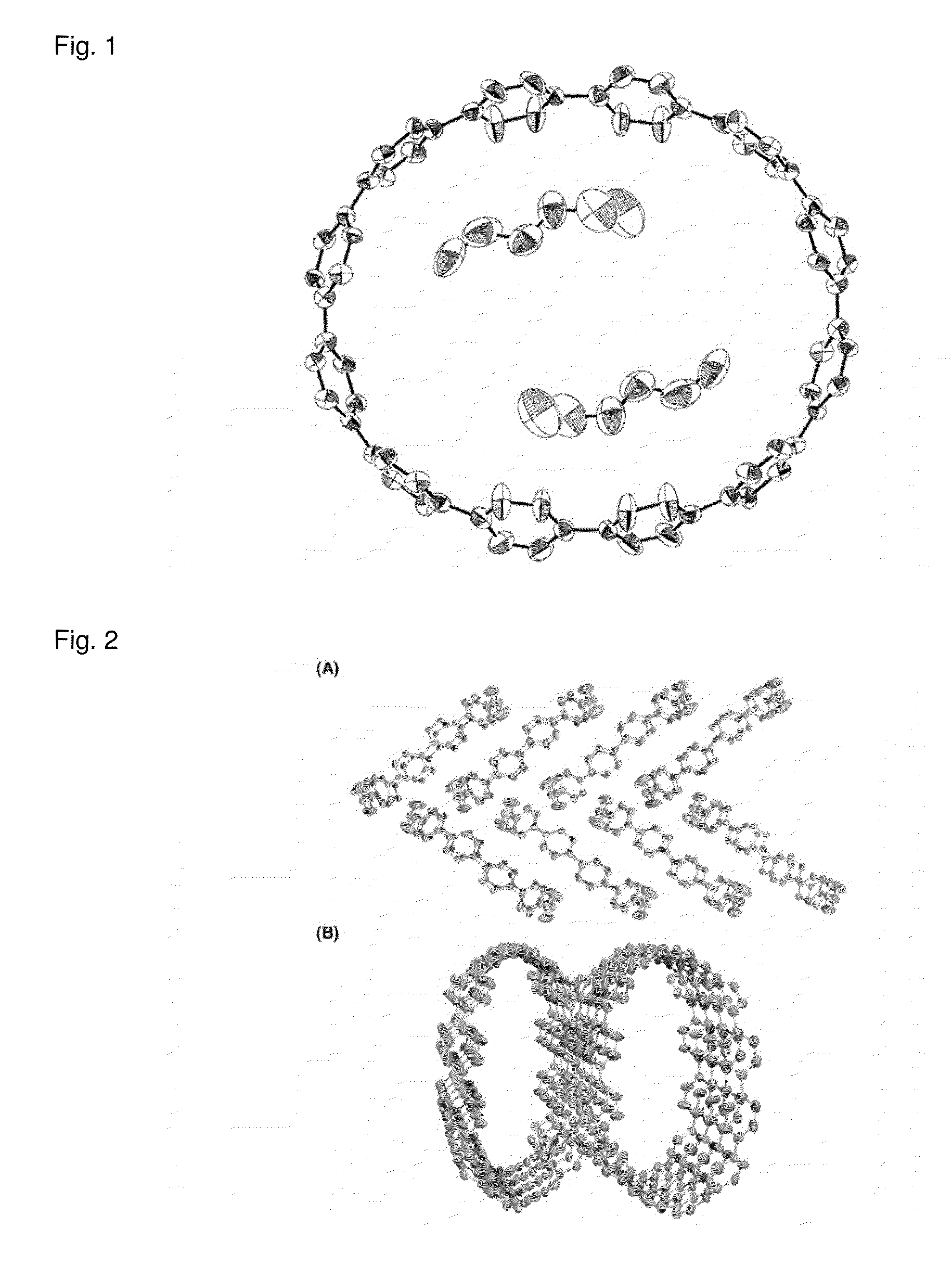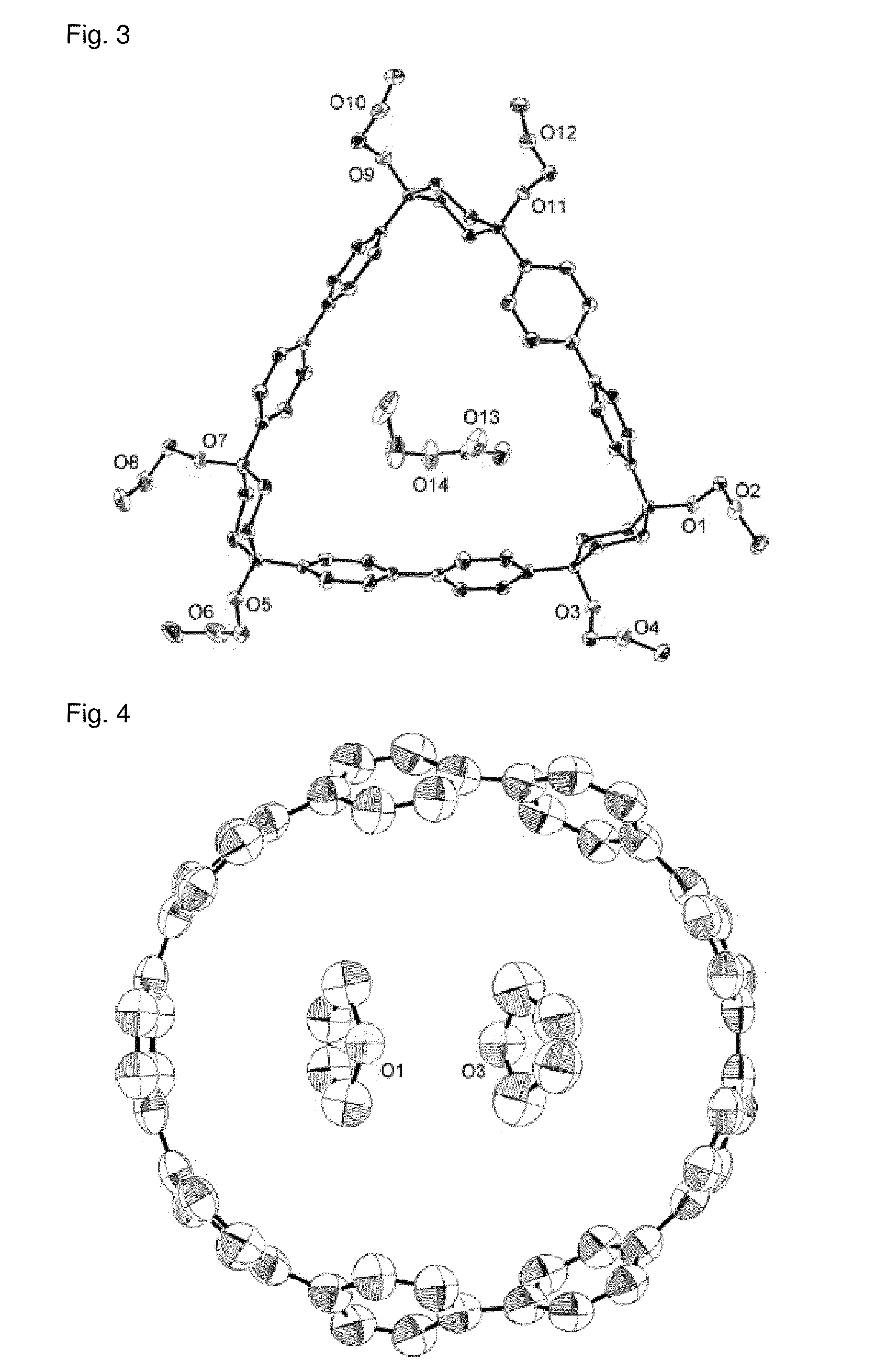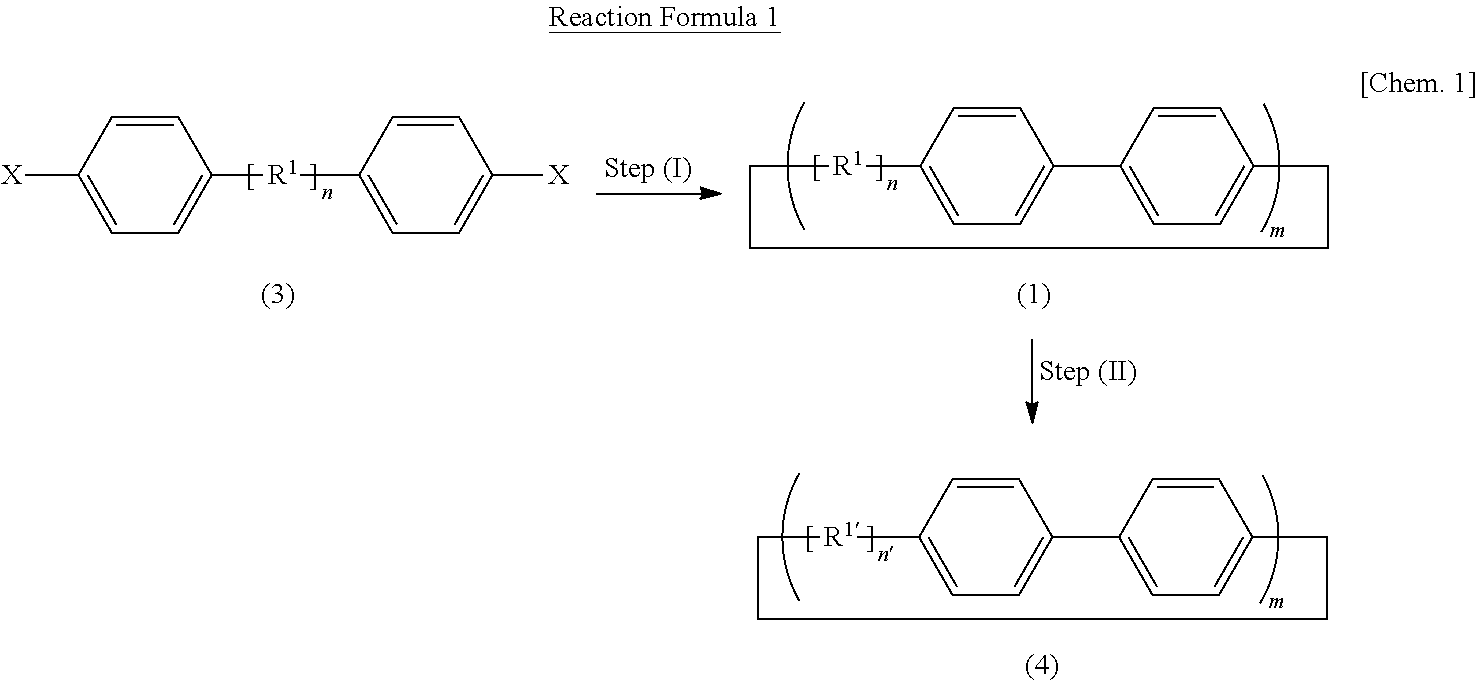Carbon nanoring and method for producing a ring-shaped compound suitable as a starting material for production of the same
a carbon nanotube and ring technology, applied in the direction of organic chemistry, chemical apparatus and processes, hydrocarbon preparation catalysts, etc., can solve the problems of mixing carbon nanotubes with various diameters and lengths, and achieve the effect of accurately designing and obtaining, short production process, and reducing production costs
- Summary
- Abstract
- Description
- Claims
- Application Information
AI Technical Summary
Benefits of technology
Problems solved by technology
Method used
Image
Examples
embodiments
[4] Embodiments
[0220]Embodiments of the present invention are shown below.
(a) A Carbon Nanoring Having 12 p-Phenylene Groups
[0221]By using Compound (3a-1) represented by General Formula (3a-1):
[0222]wherein X and R2 are as defined above,
[0223]as Compound (3), i.e., as a starting material for a carbon nanoring, a tetramer is obtained.
[0224]Thereby, Cyclic Compound (1a-1) represented by General Formula (1a-1):
[0225]wherein R2 is as defined above,
[0226]is obtained.
[0227]Cyclic Compound (1a-1) is an example of Cyclic Compound (1) in which R1 is a bivalent group represented by General Formula (2):
[0228]wherein R2 is as defined above;
[0229]n is 1; and m is 4.
[0230]Further, by subjecting Cyclic Compound (1a-1) to Step (II), a cycloparaphenylene compound (which hereinafter may also be referred to as “[12]cycloparaphenylene”) that has 12 p-phenylene groups and is represented by the following Formula (4a-1):
is obtained.
[0231]More specifically, a carbon nanoring made of [12]cycloparaphenylene ...
synthesis example 1
Synthesis of cis-1,4-bis(4-iodophenyl)-1,4-cyclohexanediol (Compound (3a-1a)) (Part 1)
[0257]To a reactor containing an argon gas atmosphere were added 1,4-diiodobenzene (49.5 g, 150 mmol) and anhydrous tetrahydrofuran (300 cm3) at room temperature (25° C.), and the resulting solution was cooled to −78° C. Thereafter, a solution of n-butyllithium in hexane (93.8 cm3, 1.6 M, 150 mmol) was slowly added thereto (addition rate: 3 cm3 / min). After completion of the addition, the mixture was stirred for 1 hour while the temperature was maintained (−78° C.). Subsequently, while the reaction liquid was stirred, a solution of cyclohexane-1,4-diene (5.68 g, 50 mmol) in anhydrous tetrahydrofuran (160 cm3), separately prepared under argon gas atmosphere, was added thereto, and the mixture was reacted at −78° C. for 1 hour, and then at room temperature (25° C.) for 2 hours. After completion of the reaction, distilled water (100 cm3) and ethyl acetate (500 cm3) were added to the reaction liquid who...
synthesis example 2
Synthesis of cis-1,4-bis(4-iodophenyl)-1,4-cyclohexanediol (Compound (3a-1a)) (Part 2)
[0259]To a reactor containing an argon gas atmosphere were added 1,4-diiodobenzene (49.5 g, 150 mmol) and anhydrous tetrahydrofuran (500 cm3) at room temperature (25° C.), and the resulting solution was cooled to −78° C. Thereafter, a solution of n-butyllithium in hexane (93.8 cm3, 1.6 M, 150 mmol) was slowly added to the resulting solution (addition rate: 3 cm3 / min). After completion of the addition, the mixture was stirred for 1 hour while the temperature was maintained (−78° C.). Thereafter, while the reaction liquid was stirred, a solution of cyclohexane-1,4-diene (5.68 g, 50 mmol) in anhydrous tetrahydrofuran (70 cm3), separately prepared under argon gas atmosphere, was added thereto. After completion of the addition, the mixture was stirred and reacted at −78° C. for 1 hour, and then at room temperature (25° C.) for 2 hours. Thereafter, a saturated ammonium chloride aqueous solution (300 cm3)...
PUM
| Property | Measurement | Unit |
|---|---|---|
| acute angle | aaaaa | aaaaa |
| inner angle | aaaaa | aaaaa |
| inner angle | aaaaa | aaaaa |
Abstract
Description
Claims
Application Information
 Login to View More
Login to View More - R&D
- Intellectual Property
- Life Sciences
- Materials
- Tech Scout
- Unparalleled Data Quality
- Higher Quality Content
- 60% Fewer Hallucinations
Browse by: Latest US Patents, China's latest patents, Technical Efficacy Thesaurus, Application Domain, Technology Topic, Popular Technical Reports.
© 2025 PatSnap. All rights reserved.Legal|Privacy policy|Modern Slavery Act Transparency Statement|Sitemap|About US| Contact US: help@patsnap.com



